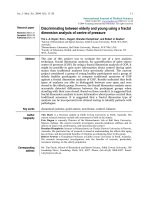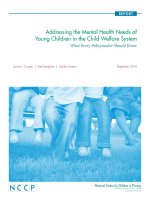Leukotriene inhibitors for bronchiolitis ininfants and young children
Bạn đang xem bản rút gọn của tài liệu. Xem và tải ngay bản đầy đủ của tài liệu tại đây (417.77 KB, 20 trang )
LEUKOTRIENE INHIBITORS
FOR BRONCHIOLITIS IN
INFANTS AND YOUNG
CHILDREN
DR. TRÌNH THỊ NGÀ
BACKGROUND
Bronchiolitis is a common acute inflammatory illness
of the bronchioles
10% of children in high-income countries contract
bronchiolitis in the first year of life, 2% - 3% :
hospitalisation
BACKGROUND
The cause: respiratory syncytial virus (RSV),
parainfluenza, influenza, adenovirus and rhinovirus.
the absence of clear scientific evidence for a
specific treatment approach.
Bronchodilators, antibiotics and steroids are
widely used but not routinely recommended.
→ new treatment approaches are necessary.
BACKGROUND
Leukotriene inhibitors (LI) can decrease the
concentration of leukotrienes and reduce the
symptoms of wheezing and coughing.
BACKGROUND
Montelukast has been approved by the US Food
and Drug Administration (FDA) for use in children <
2 years.
OBJECTIVES
To assess the efficacy and safety of leukotriene
inhibitors for bronchiolitis in infants and young
children.
METHODS
Criteria for considering studies for this review:
Types of studies: RCTs comparing leukotriene
inhibitors with control (placebo or other
interventions).
Types of participants: infants and children < 24
months, with physician-diagnosed bronchiolitis
METHODS
Types of outcome measures:
Primary outcomes
1. Length of hospital stay.
2. All-cause mortality.
Secondary outcomes
1. Clinical severity score.
2. Percentage of symptom-free days.
3. Percentage of children requiring ventilation.
4. Oxygen saturation.
5. Recurrent wheezing.
6. Respiratory rate.
7. Clinical adverse effects.
RESULTS OF THE SEARCH
5 RCTs: Denmark, Mexico, Singapore, South Africa,
USA, South Korea and Japan, Belgium, Egypt and
Israel.
1296 participants hospitalised.
Intervention: 4 mg montelukast → discharge/ for
several weeks.
Follow up: 3 - 12 months.
RESULTS
1. Length of hospital stay: mean difference (MD) 0.95 days, 95% confidence interval (CI) -3.08 - 1.19,
P = 0.38.
RESULTS
2. All - cause mortality:
RESULTS
4. Clinical severity day score (day2):
RESULTS
5. Clinical severity day score (day3):
RESULTS
6.
7.
8.
9.
Percentage of children requiring ventilation
Oxygen saturation
Respiratory rate
→ No relevant data were available
Recurrent wheezing:
One study reported/1 years: did not reduce the
incidence of recurrent wheezing.
RESULTS
10.
Clinical adverse effects:
One study of 952 children reported 2 deaths in the
leukotriene inhibitors group: neither was determined
to be drug-related.
adverse events: diarrhoea, wheezing shortly after
administration and rash.
CONCLUSIONS
The current evidence does not allow definitive
conclusions to be made about the effects of LI on
length of hospital stay and clinical severity score.
The quality of the evidence was low.
Further large studies are required.
THANK YOU!









